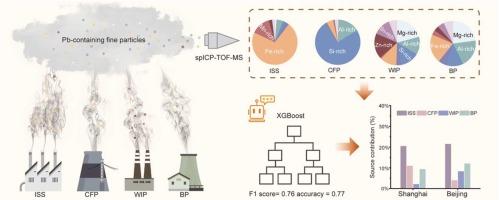Source-specific fingerprints and machine learning-driven apportionment of lead-containing fine particles from typical industrial emissions in China
IF 11.3
1区 环境科学与生态学
Q1 ENGINEERING, ENVIRONMENTAL
引用次数: 0
Abstract
Lead-containing fine particles (Pb-FPs) from industrial emissions pose significant health risks, but their source-specific characteristics remain poorly characterized. This study presents a comprehensive investigation of Pb-FPs derived from four major industrial sectors in China, i.e. coal-fired power (CFP), iron and steel smelting (ISS), waste incineration power (WIP), and biomass power generation (BP), through systematic analysis of 134 PM samples collected nationwide using single-particle inductively coupled plasma time-of-flight mass spectrometry (spICP-TOF-MS). Our results showed that WIP (5×107 particles/mg) and ISS (3.9×107 particles/mg) activities emitted significantly higher number concentrations of Pb-FPs compared to CFP and BP sources.Pb-multi-metal FPs accounted for 66.7-81.2% of total Pb-FPs number concentrations across all sources, with the mass fraction of Pb was predominantly ≤ 10%. Distinct elemental fingerprints were identified for each source type, particularly metal-rich matrices associated with Pb. We developed a source apportionment approach by evaluating five machine learning algorithms, with XGBoost emerging as the optimal classifier (F1 score = 0.76, accuracy = 0.77) after Bayesian optimization and 10-fold cross-validation. Application of the model to PM2.5 samples from Beijing and Shanghai revealed persistent and substantial contributions from ISS-derived Pb-FPs (6.7-38.1% in Beijing, 10.5-33.7% in Shanghai), with additional average inputs from CFP (7.4%), WIP (5.8%), and BP (12.1%). These results highlight the dominant role of ISS in atmospheric Pb pollution across industrialized regions of China and emphasize the need for targeted mitigation strategies.

中国典型工业排放中含铅细颗粒的来源特定指纹和机器学习驱动的分析
来自工业排放的含铅细颗粒(Pb-FPs)构成重大健康风险,但其特定来源的特征仍然不清楚。本研究利用单粒子电感耦合等离子体飞行时间质谱(spICP-TOF-MS)对全国收集的134份PM样品进行系统分析,对中国燃煤发电(CFP)、钢铁冶炼(ISS)、垃圾焚烧发电(WIP)和生物质发电(BP)四个主要工业部门的Pb-FPs进行了全面调查。结果表明,WIP (5×107 particles/mg)和ISS (3.9×107 particles/mg)释放的Pb-FPs数量浓度显著高于CFP和BP源。各来源Pb-多金属FPs占总Pb-FPs数浓度的66.7-81.2%,Pb质量分数以≤10%为主。每种来源类型都有不同的元素指纹图谱,特别是与Pb相关的富金属基质。我们通过评估五种机器学习算法开发了一种源分配方法,经过贝叶斯优化和10倍交叉验证,XGBoost成为最优分类器(F1得分= 0.76,准确率= 0.77)。将该模型应用于北京和上海的PM2.5样本,结果显示,来自国际空间观测系统的Pb-FPs(北京为6.7-38.1%,上海为10.5-33.7%)的贡献持续而显著,CFP(7.4%)、WIP(5.8%)和BP(12.1%)的额外平均投入。这些结果强调了ISS在中国工业化地区大气铅污染中的主导作用,并强调了有针对性的缓解策略的必要性。
本文章由计算机程序翻译,如有差异,请以英文原文为准。
求助全文
约1分钟内获得全文
求助全文
来源期刊

Journal of Hazardous Materials
工程技术-工程:环境
CiteScore
25.40
自引率
5.90%
发文量
3059
审稿时长
58 days
期刊介绍:
The Journal of Hazardous Materials serves as a global platform for promoting cutting-edge research in the field of Environmental Science and Engineering. Our publication features a wide range of articles, including full-length research papers, review articles, and perspectives, with the aim of enhancing our understanding of the dangers and risks associated with various materials concerning public health and the environment. It is important to note that the term "environmental contaminants" refers specifically to substances that pose hazardous effects through contamination, while excluding those that do not have such impacts on the environment or human health. Moreover, we emphasize the distinction between wastes and hazardous materials in order to provide further clarity on the scope of the journal. We have a keen interest in exploring specific compounds and microbial agents that have adverse effects on the environment.
 求助内容:
求助内容: 应助结果提醒方式:
应助结果提醒方式:


